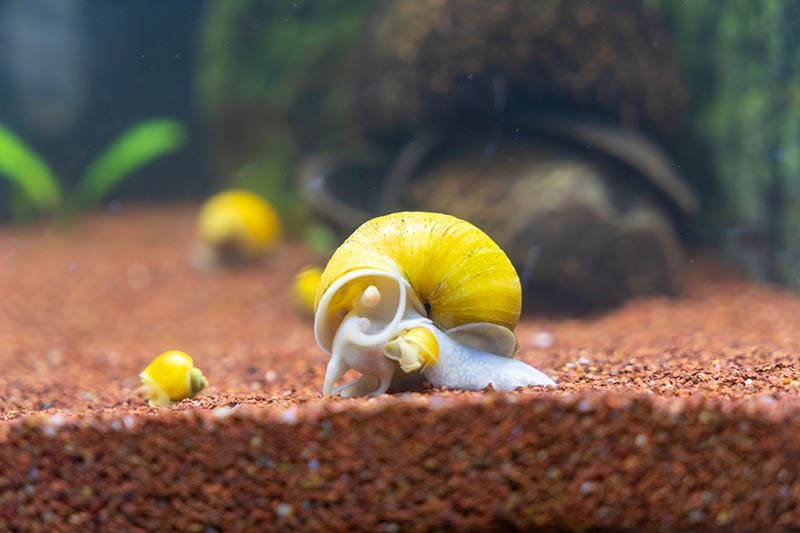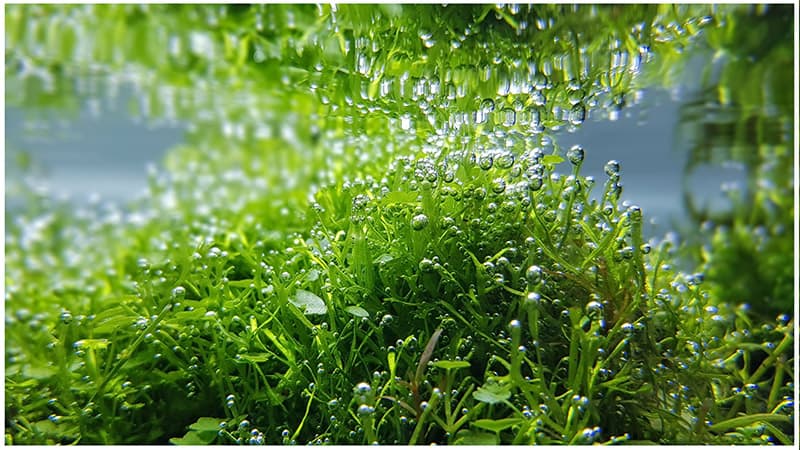Plant diseases occur mainly due to unproperly cared for aquariums.
Aquatic plant aquariums that are provided with the proper nutrients and lighting, as well as given general maintenance should rarely encounter any major problems. Minor damage can result from fish, snails, and other organisms biting at them, but healthy plants should be able to endure this.
If you have equipped your aquarium with the necessary lighting, filtration and heat, and provided the proper nutrients yet your plants do not appear to be lush and thriving, then other common plant diseases may exist.
You can usually identify plant disease by observing your water plants as well as your aquarium inhabitants. The browsing of fish, aquarium snails and other tank inhabitants, or a plant parasite such as an aphid on your aquarium plants may be the culprit. Or there may be a plant disease resulting from insufficient nutrients, faulty equipment, needed tank maintenance, or plant care.
Browsing Fish
Many fish can eat plants faster than they can grow. A number of Characins such as the Silver Dollars, Scats, and Headstanders have been known to snack on anything green. Other Characins at times tend to pick at plants, though are less likely to do as much damage. These include the Moenkhausia Tetras (Glass Tetra, Red-eyed Tetra, and Diamond Tetra), the Serpae Tetra, Slender Hemiodus, Silver Tetra, and the Blind Cave Tetra.
Other fish may damage various broad-leaved plants such as Swordplants, Crypts, and Apongetons. Botias may punch holes through the younger leaves. Angelfish, when spawning, may suck holes in the leaves as they are cleaning them to use them as a spawning site. Various strains of Mollies, Poecilia sphenops, use their lips which are covered with fine sharp teeth, to scrape algae and tiny animals off the leaves. This may give them a worn, sandpaper appearance.
Aquarium Snails
Aquarium snails can perform important functions in the tank, acting as scavengers and polishers. But In certain circumstances snails may browse on plants, especially if they don’t have other foods available. Aquatic snails can also simply become too crowded.
- Apple Snail:
The giant Florida Apple Snail, Ampullaria paludosa, is the most notorious example of a destructive snail. It is also called the Infusoria Snail or the Nursemade. It is a destructive feeder with a voracious appetite and is best not kept in a planted aquarium. - Mystery Snail:
The Mystery Snail, Ampullaria cuprina, is a close relative of the Apple Snail but much more plant tank friendly. It will only eat aquarium plants as a last resort if adequate food isn’t available. They would prefer to eat white worms or algae and tiny animals living on the surface of plants, the decor, and the glass sides of the aquarium. If this food source runs out, then they will then start snacking on the softer ornamental plants such as Water Sprite, Ambulia, and Hygrophila, and then possibly young Swordplant leaves. - Philippine Livebearer:
The little Philippine Livebearer acts as a valuable gravel cleaner an plant cultivator without being destructive - Ramshorn:
The Ramshorns, Helisoma or Planorbis species, propagate quickly and will have to be removed frequently. They are the most sensitive of the aquatic snails to eradication with copper based products
To rid a plant tank of unwanted snails you can remove them manually. You can also introduce Gold Barbs (or small turtles in a pond) to effectively eradicate snails naturally. Another simple method is to poison them. There are several types of chemical snail eradicators available which are based on copper. Copper can be toxic to aquarium plants, especially if too much is added. It can also be detrimental, even fatal, to some fish like Plecostomus, Loaches, White Clouds, and some Barbs. Copper based products must be used carefully and be sure to follow the instructions.

Aphids/insects
Sometimes, aphids and other small insects can colonize on aquarium plants if the air is too dry. The best way to remedy this is to catch it early and remove the parts of the plant that are heavily infested. Crushing the aphids with your fingers and feeding them to the fish is another great way to help get rid of them. Also, rinse the plants thoroughly with fresh water to rid them of the parasites.
Nutrients
Common plant diseases can result if the correct nutrients aren’t being supplied in the correct amounts. If you start noticing problems make sure to fertilize regularly. Also do partial water changes once a week. If it seems that there is a deficiency of one of the micro nutrients, ways to increase it include fertilizing, using nutrient-rich substrates, and using tap water when changing the water.
- For more on plant care see: Aquarium Plant Feeding and Maintenance – Plant Food and Aquarium co2 Systems

Aquarium Equipment and Maintenance
If you notice that your plants are looking weak, frail, having thinning leaves and stems, or have yellowish leaves, you may want to check your equipment. Make sure you have the correct equipment for the particular plant species. Look for things such as how much light is supplied and what color it is, and also the water temperature. Then you will want to check the equipment on a regular basis to make everything is working correctly.
- For more information see: Setting Up a Planted Aquarium – Lighting, Heating and Filtration For Live Aquarium Plants
Featured Image Credit: Cheng Wei, Shutterstock
